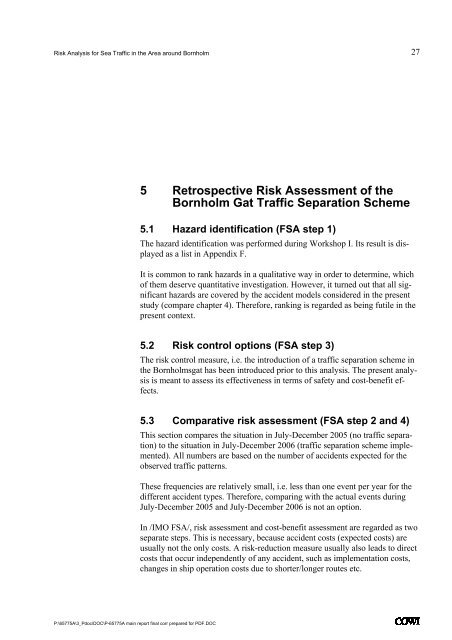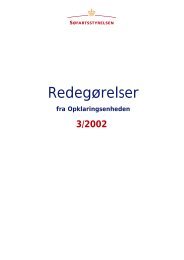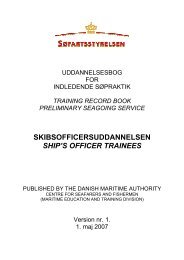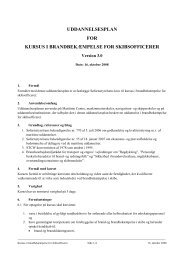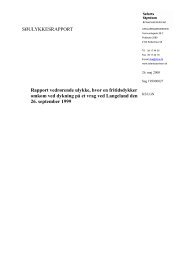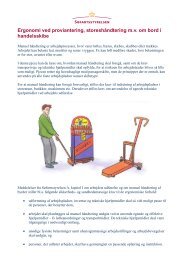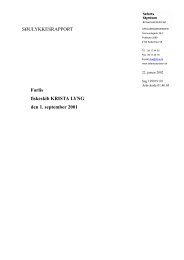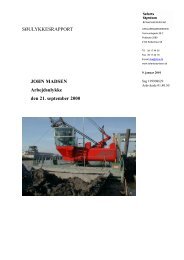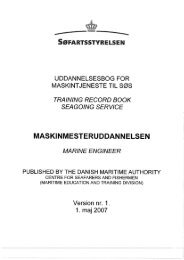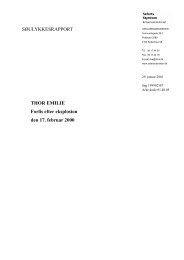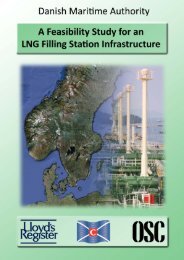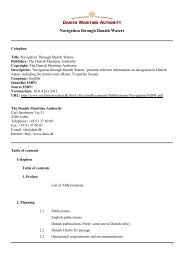Risk Analysis of Sea Traffic in the Area around Bornholm, 2008. - VTT
Risk Analysis of Sea Traffic in the Area around Bornholm, 2008. - VTT
Risk Analysis of Sea Traffic in the Area around Bornholm, 2008. - VTT
- No tags were found...
Create successful ePaper yourself
Turn your PDF publications into a flip-book with our unique Google optimized e-Paper software.
<strong>Risk</strong> <strong>Analysis</strong> for <strong>Sea</strong> <strong>Traffic</strong> <strong>in</strong> <strong>the</strong> <strong>Area</strong> <strong>around</strong> <strong>Bornholm</strong><br />
27<br />
5 Retrospective <strong>Risk</strong> Assessment <strong>of</strong> <strong>the</strong><br />
<strong>Bornholm</strong> Gat <strong>Traffic</strong> Separation Scheme<br />
5.1 Hazard identification (FSA step 1)<br />
The hazard identification was performed dur<strong>in</strong>g Workshop I. Its result is displayed<br />
as a list <strong>in</strong> Appendix F.<br />
It is common to rank hazards <strong>in</strong> a qualitative way <strong>in</strong> order to determ<strong>in</strong>e, which<br />
<strong>of</strong> <strong>the</strong>m deserve quantitative <strong>in</strong>vestigation. However, it turned out that all significant<br />
hazards are covered by <strong>the</strong> accident models considered <strong>in</strong> <strong>the</strong> present<br />
study (compare chapter 4). Therefore, rank<strong>in</strong>g is regarded as be<strong>in</strong>g futile <strong>in</strong> <strong>the</strong><br />
present context.<br />
5.2 <strong>Risk</strong> control options (FSA step 3)<br />
The risk control measure, i.e. <strong>the</strong> <strong>in</strong>troduction <strong>of</strong> a traffic separation scheme <strong>in</strong><br />
<strong>the</strong> <strong>Bornholm</strong>sgat has been <strong>in</strong>troduced prior to this analysis. The present analysis<br />
is meant to assess its effectiveness <strong>in</strong> terms <strong>of</strong> safety and cost-benefit effects.<br />
5.3 Comparative risk assessment (FSA step 2 and 4)<br />
This section compares <strong>the</strong> situation <strong>in</strong> July-December 2005 (no traffic separation)<br />
to <strong>the</strong> situation <strong>in</strong> July-December 2006 (traffic separation scheme implemented).<br />
All numbers are based on <strong>the</strong> number <strong>of</strong> accidents expected for <strong>the</strong><br />
observed traffic patterns.<br />
These frequencies are relatively small, i.e. less than one event per year for <strong>the</strong><br />
different accident types. Therefore, compar<strong>in</strong>g with <strong>the</strong> actual events dur<strong>in</strong>g<br />
July-December 2005 and July-December 2006 is not an option.<br />
In /IMO FSA/, risk assessment and cost-benefit assessment are regarded as two<br />
separate steps. This is necessary, because accident costs (expected costs) are<br />
usually not <strong>the</strong> only costs. A risk-reduction measure usually also leads to direct<br />
costs that occur <strong>in</strong>dependently <strong>of</strong> any accident, such as implementation costs,<br />
changes <strong>in</strong> ship operation costs due to shorter/longer routes etc.<br />
P:\65775A\3_Pdoc\DOC\P-65775A ma<strong>in</strong> report f<strong>in</strong>al corr prepared for PDF.DOC<br />
.


